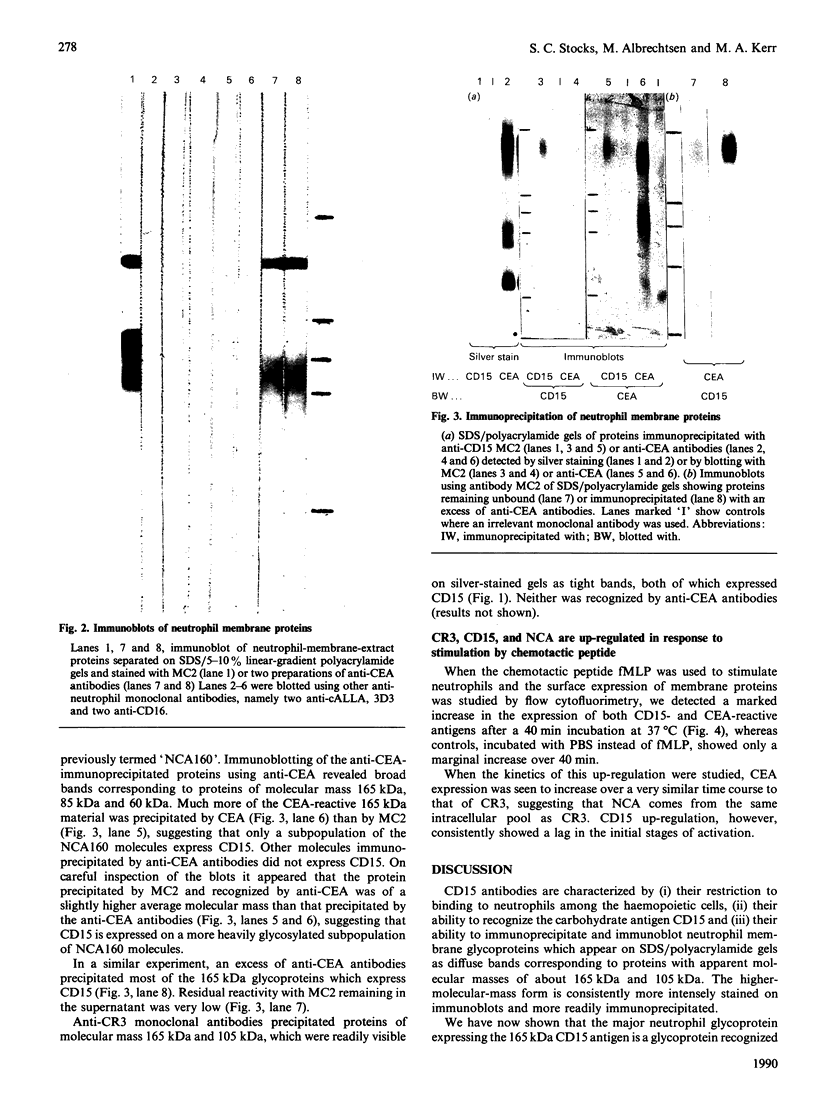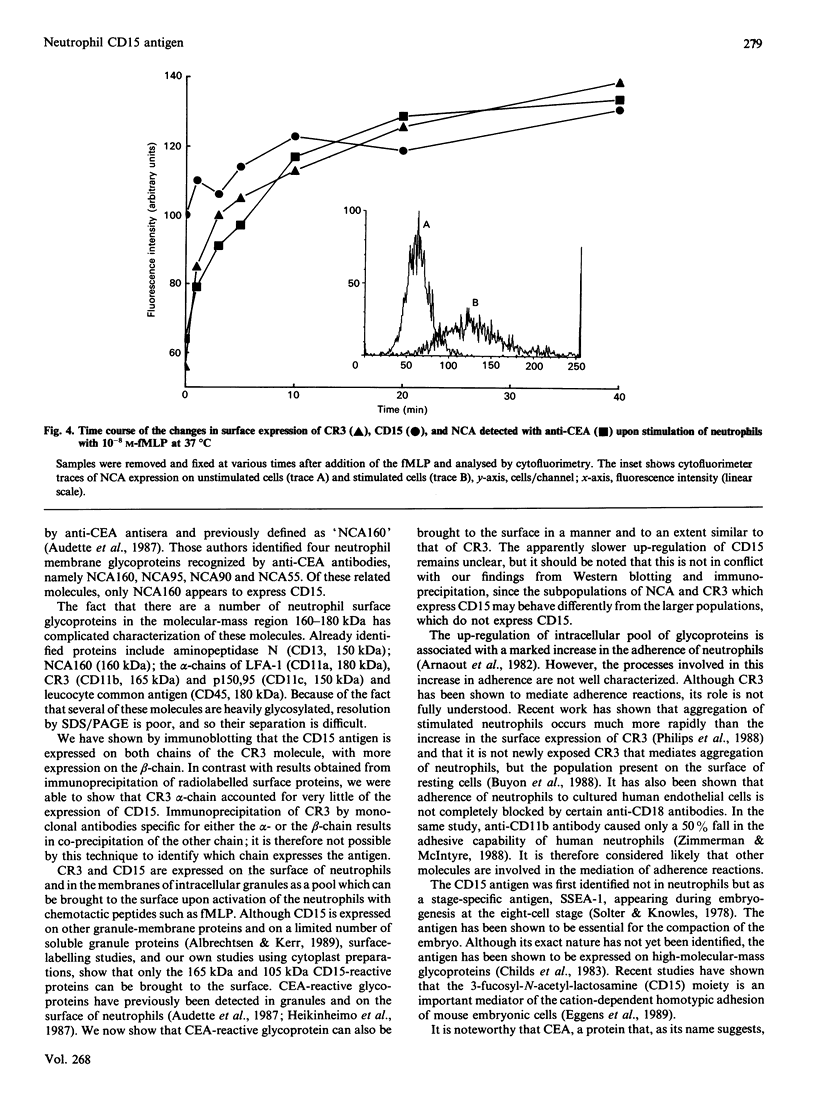Abstract
The expression of the carbohydrate antigen 3-fucosyl-N-acetyl-lactosamine (CD15, LeX) on human neutrophil glycoproteins has been studied by immunoprecipitation and immunoblotting by using monoclonal antibody MC2. The antigen is expressed on membrane glycoproteins of approximate molecular mass 165 and 105 kDa. These glycoproteins include the complement receptor and adhesion molecule, CR3, in which the beta-chain (CD18, 105 kDa) shows much greater expression than the alpha-chain (CD11b, 165 kDa). Most of the 165 kDa CD15 antigen is accounted for by expression on the carcinoembryonic antigen (CEA)-related molecule NCA160. Other members of this family, NCA95, NCA90 and NCA55, which are also found in neutrophils, do not express the CD15 antigen. There is a marked increase in the surface expression of CD15, CR3 and the antigen recognized by anti-CEA antibodies upon activation of neutrophils by the chemotactic peptide N-formylmethionyl-leucylphenylalanine.
Full text
PDF





Images in this article
Selected References
These references are in PubMed. This may not be the complete list of references from this article.
- Albrechtsen M., Kerr M. A. Characterization of human neutrophil glycoproteins expressing the CD15 differentiation antigen (3-fucosyl-N-acetyllactosamine). Br J Haematol. 1989 Jul;72(3):312–320. doi: 10.1111/j.1365-2141.1989.tb07710.x. [DOI] [PubMed] [Google Scholar]
- Arnaout M. A., Hakim R. M., Todd R. F., 3rd, Dana N., Colten H. R. Increased expression of an adhesion-promoting surface glycoprotein in the granulocytopenia of hemodialysis. N Engl J Med. 1985 Feb 21;312(8):457–462. doi: 10.1056/NEJM198502213120801. [DOI] [PubMed] [Google Scholar]
- Audette M., Buchegger F., Schreyer M., Mach J. P. Monoclonal antibody against carcinoembryonic antigen (CEA) identifies two new forms of crossreacting antigens of molecular weight 90,000 and 160,000 in normal granulocytes. Mol Immunol. 1987 Nov;24(11):1177–1186. doi: 10.1016/0161-5890(87)90164-7. [DOI] [PubMed] [Google Scholar]
- Benchimol S., Fuks A., Jothy S., Beauchemin N., Shirota K., Stanners C. P. Carcinoembryonic antigen, a human tumor marker, functions as an intercellular adhesion molecule. Cell. 1989 Apr 21;57(2):327–334. doi: 10.1016/0092-8674(89)90970-7. [DOI] [PubMed] [Google Scholar]
- Buyon J. P., Abramson S. B., Philips M. R., Slade S. G., Ross G. D., Weissmann G., Winchester R. J. Dissociation between increased surface expression of gp165/95 and homotypic neutrophil aggregation. J Immunol. 1988 May 1;140(9):3156–3160. [PubMed] [Google Scholar]
- Childs R. A., Pennington J., Uemura K., Scudder P., Goodfellow P. N., Evans M. J., Feizi T. High-molecular-weight glycoproteins are the major carriers of the carbohydrate differentiation antigens I, i and SSEA-1 of mouse teratocarcinoma cells. Biochem J. 1983 Dec 1;215(3):491–503. doi: 10.1042/bj2150491. [DOI] [PMC free article] [PubMed] [Google Scholar]
- Detmers P. A., Wright S. D. Adhesion-promoting receptors on leukocytes. Curr Opin Immunol. 1988 Sep-Oct;1(1):10–15. doi: 10.1016/0952-7915(88)90045-3. [DOI] [PubMed] [Google Scholar]
- Eggens I., Fenderson B., Toyokuni T., Dean B., Stroud M., Hakomori S. Specific interaction between Lex and Lex determinants. A possible basis for cell recognition in preimplantation embryos and in embryonal carcinoma cells. J Biol Chem. 1989 Jun 5;264(16):9476–9484. [PubMed] [Google Scholar]
- Forsyth K. D., Simpson A. C., Levinsky R. J. CD15 antibodies increase neutrophil adhesion to endothelium by an LFA-1-dependent mechanism. Eur J Immunol. 1989 Jul;19(7):1331–1334. doi: 10.1002/eji.1830190727. [DOI] [PubMed] [Google Scholar]
- Fox N., Damjanov I., Knowles B. B., Solter D. Immunohistochemical localization of the mouse stage-specific embryonic antigen 1 in human tissues and tumors. Cancer Res. 1983 Feb;43(2):669–678. [PubMed] [Google Scholar]
- Gooi H. C., Thorpe S. J., Hounsell E. F., Rumpold H., Kraft D., Förster O., Feizi T. Marker of peripheral blood granulocytes and monocytes of man recognized by two monoclonal antibodies VEP8 and VEP9 involves the trisaccharide 3-fucosyl-N-acetyllactosamine. Eur J Immunol. 1983 Apr;13(4):306–312. doi: 10.1002/eji.1830130407. [DOI] [PubMed] [Google Scholar]
- Harlan J. M., Killen P. D., Senecal F. M., Schwartz B. R., Yee E. K., Taylor R. F., Beatty P. G., Price T. H., Ochs H. D. The role of neutrophil membrane glycoprotein GP-150 in neutrophil adherence to endothelium in vitro. Blood. 1985 Jul;66(1):167–178. [PubMed] [Google Scholar]
- Heikinheimo M., Gahmberg C. G., Bohn H., Andersson L. C. Oncoplacental protein SP1--a constitutive and inducible late differentiation marker of the human myelomonocytic lineage. Blood. 1987 Nov;70(5):1279–1283. [PubMed] [Google Scholar]
- Horejsí V., Bazil V. Surface proteins and glycoproteins of human leucocytes. Biochem J. 1988 Jul 1;253(1):1–26. doi: 10.1042/bj2530001. [DOI] [PMC free article] [PubMed] [Google Scholar]
- Huang L. C., Civin C. I., Magnani J. L., Shaper J. H., Ginsburg V. My-1, the human myeloid-specific antigen detected by mouse monoclonal antibodies, is a sugar sequence found in lacto-N-fucopentaose III. Blood. 1983 May;61(5):1020–1023. [PubMed] [Google Scholar]
- Hynes R. O. Integrins: a family of cell surface receptors. Cell. 1987 Feb 27;48(4):549–554. doi: 10.1016/0092-8674(87)90233-9. [DOI] [PubMed] [Google Scholar]
- Kerr M. A., McCarthy N. C. A carbohydrate differentiation antigen of granulocytes, brain and many tumours. Biochem Soc Trans. 1985 Apr;13(2):424–426. doi: 10.1042/bst0130424a. [DOI] [PubMed] [Google Scholar]
- Khan W. N., Hammarström S. Carcinoembryonic antigen gene family: molecular cloning of cDNA for a PS beta G/FL-NCA glycoprotein with a novel domain arrangement. Biochem Biophys Res Commun. 1989 Jun 15;161(2):525–535. doi: 10.1016/0006-291x(89)92631-4. [DOI] [PubMed] [Google Scholar]
- Laemmli U. K. Cleavage of structural proteins during the assembly of the head of bacteriophage T4. Nature. 1970 Aug 15;227(5259):680–685. doi: 10.1038/227680a0. [DOI] [PubMed] [Google Scholar]
- McCarthy N. C., Albrechtsen M. T., Kerr M. A. Characterization of a human granulocyte differentiation antigen (CDw15) commonly recognized by monoclonal antibodies. Biosci Rep. 1985 Oct-Nov;5(10-11):933–941. doi: 10.1007/BF01119906. [DOI] [PubMed] [Google Scholar]
- Melnick D. A., Meshulam T., Manto A., Malech H. L. Activation of human neutrophils by monoclonal antibody PMN7C3: cell movement and adhesion can be triggered independently from the respiratory burst. Blood. 1986 May;67(5):1388–1394. [PubMed] [Google Scholar]
- Melnick D. A., Nauseef W. M., Markowitz S. D., Gardner J. P., Malech H. L. Biochemical analysis and subcellular localization of a neutrophil-specific antigen, PMN-7, involved in the respiratory burst. J Immunol. 1985 May;134(5):3346–3355. [PubMed] [Google Scholar]
- Morrissey J. H. Silver stain for proteins in polyacrylamide gels: a modified procedure with enhanced uniform sensitivity. Anal Biochem. 1981 Nov 1;117(2):307–310. doi: 10.1016/0003-2697(81)90783-1. [DOI] [PubMed] [Google Scholar]
- Philips M. R., Buyon J. P., Winchester R., Weissmann G., Abramson S. B. Up-regulation of the iC3b receptor (CR3) is neither necessary nor sufficient to promote neutrophil aggregation. J Clin Invest. 1988 Aug;82(2):495–501. doi: 10.1172/JCI113623. [DOI] [PMC free article] [PubMed] [Google Scholar]
- Ross G. D., Cain J. A., Lachmann P. J. Membrane complement receptor type three (CR3) has lectin-like properties analogous to bovine conglutinin as functions as a receptor for zymosan and rabbit erythrocytes as well as a receptor for iC3b. J Immunol. 1985 May;134(5):3307–3315. [PubMed] [Google Scholar]
- Sanders D. S., Kerr M. A., Hopwood D., Coghill G., Milne G. A. Expression of the 3-fucosyl N-acetyllactosamine (CD 15) antigen in normal, metaplastic, dysplastic, and neoplastic squamous epithelia. J Pathol. 1988 Mar;154(3):255–262. doi: 10.1002/path.1711540308. [DOI] [PubMed] [Google Scholar]
- Skubitz K. M., Pessano S., Bottero L., Ferrero D., Rovera G., August J. T. Human granulocyte surface molecules identified by murine monoclonal antibodies. J Immunol. 1983 Oct;131(4):1882–1888. [PubMed] [Google Scholar]
- Skubitz K. M., Snook R. W., 2nd Monoclonal antibodies that recognize lacto-N-fucopentaose III (CD15) react with the adhesion-promoting glycoprotein family (LFA-1/HMac-1/gp 150,95) and CR1 on human neutrophils. J Immunol. 1987 Sep 1;139(5):1631–1639. [PubMed] [Google Scholar]
- Solter D., Knowles B. B. Monoclonal antibody defining a stage-specific mouse embryonic antigen (SSEA-1). Proc Natl Acad Sci U S A. 1978 Nov;75(11):5565–5569. doi: 10.1073/pnas.75.11.5565. [DOI] [PMC free article] [PubMed] [Google Scholar]
- Springer T. A., Anderson D. C. Leukocyte complement receptors and adhesion proteins in the inflammatory response: insights from an experiment of nature. Biochem Soc Symp. 1986;51:47–57. [PubMed] [Google Scholar]
- Springer T. A., Thompson W. S., Miller L. J., Schmalstieg F. C., Anderson D. C. Inherited deficiency of the Mac-1, LFA-1, p150,95 glycoprotein family and its molecular basis. J Exp Med. 1984 Dec 1;160(6):1901–1918. doi: 10.1084/jem.160.6.1901. [DOI] [PMC free article] [PubMed] [Google Scholar]
- Streydio C., Lacka K., Swillens S., Vassart G. The human pregnancy-specific beta 1-glycoprotein (PS beta G) and the carcinoembryonic antigen (CEA)-related proteins are members of the same multigene family. Biochem Biophys Res Commun. 1988 Jul 15;154(1):130–137. doi: 10.1016/0006-291x(88)90660-2. [DOI] [PubMed] [Google Scholar]
- Tetteroo P. A., Mulder A., Lansdorp P. M., Zola H., Baker D. A., Visser F. J., von dem Borne A. E. Myeloid-associated antigen 3-alpha-fucosyl-N-acetyllactosamine (FAL): location on various granulocyte membrane glycoproteins and masking upon monocytic differentiation. Eur J Immunol. 1984 Dec;14(12):1089–1095. doi: 10.1002/eji.1830141205. [DOI] [PubMed] [Google Scholar]
- Towbin H., Staehelin T., Gordon J. Electrophoretic transfer of proteins from polyacrylamide gels to nitrocellulose sheets: procedure and some applications. Proc Natl Acad Sci U S A. 1979 Sep;76(9):4350–4354. doi: 10.1073/pnas.76.9.4350. [DOI] [PMC free article] [PubMed] [Google Scholar]
- Williams A. F., Barclay A. N. The immunoglobulin superfamily--domains for cell surface recognition. Annu Rev Immunol. 1988;6:381–405. doi: 10.1146/annurev.iy.06.040188.002121. [DOI] [PubMed] [Google Scholar]
- Wright S. D., Reddy P. A., Jong M. T., Erickson B. W. C3bi receptor (complement receptor type 3) recognizes a region of complement protein C3 containing the sequence Arg-Gly-Asp. Proc Natl Acad Sci U S A. 1987 Apr;84(7):1965–1968. doi: 10.1073/pnas.84.7.1965. [DOI] [PMC free article] [PubMed] [Google Scholar]
- Zimmerman G. A., McIntyre T. M. Neutrophil adherence to human endothelium in vitro occurs by CDw18 (Mo1, MAC-1/LFA-1/GP 150,95) glycoprotein-dependent and -independent mechanisms. J Clin Invest. 1988 Feb;81(2):531–537. doi: 10.1172/JCI113351. [DOI] [PMC free article] [PubMed] [Google Scholar]





